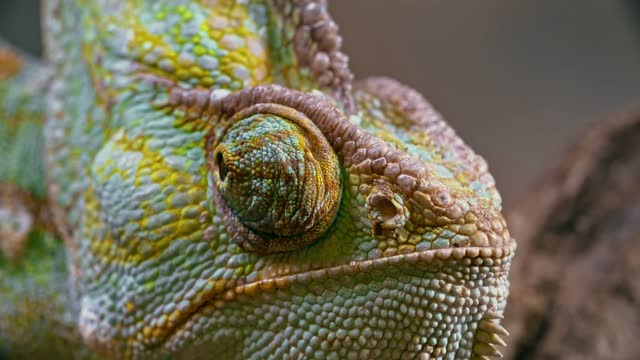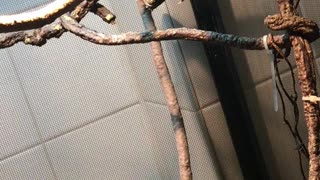Premium Only Content

the chameleon
The Chameleonids (Chamaeleonidae) are a family of mainly arboreal saurians, defined by Constantine Samuel Rafinesque in 1815. It contains nearly 200 species of chameleons. This family is divided into two sub-families: the Chamaeleoninae and the Brookesiinae (en).
They are animals which are characterized by the independent mobility of their eyes, their protractile tongue which allows them to catch their prey from a distance, the fingers grouped in two opposable coalitions ensuring a good grip on the branches, their ability to transform color , and finally their line which is used to stabilize.
Chameleons are reptiles - and lizards - that exhibit many similar anatomical and biological peculiarities.
The eyes of chameleons are prominent and have independent movements. This allows them to simultaneously monitor all sides for approaching predators. When they spot a prey, the competitor eyes on it for better precision.
Almost devoid of sticks, chameleons have very poor night vision - and have a diurnal life pattern.
Chameleons are also known for their varied colors, and especially the ability in some species to change it quickly. Their epidermis has two love seats of nanocrystals that allow them to transform color and reflect light in the near infrared.
The peripatetic philosopher Theophrastus believed that the chameleon's color change phenomenon - metamorphosis - arose from the air that fills its body: as its lungs almost occupy child mid-region, air predominates, and would facilitate color change6 .
However on the other hand, it is mainly a social correspondence mechanism (dark colors mark anger, aggressiveness, with varieties of stripes on the flanks and changing visual cues that focus on the face of the combatants; the males use light and varied colors to court the females) 7, and not of a method of cover (Alfred Edmund Brehm is the head to have defended this thesis in the nineteenth century). However most chameleons seem to use the color change for both purposes. The change of color would have appeared first of all as a means of correspondence, the disguise intervening only secondarily8,9. Bradypodion taeniabronchum uses this strategy of disguise with remarkable efficiency10.
The chameleons' dresses allow them to be identified: each has a favorite environment. Dwarf chameleons, rather terrestrial, generally have a rather brown coat, whereas arboreal species often sport green, yellow or blue.
-
 0:15
0:15
RockerRebel71
4 years agoChameleon Chow
20 -
 0:23
0:23
lexito
4 years agoChameleon cuteness
122 -
 0:31
0:31
After Shopper
4 years agoChameleon and Ferret
73 -
 0:13
0:13
BTBnour
4 years agoChameleon cat loses his mind
472 -
 4:34
4:34
constitutionalrights
4 years ago $17.29 earnedCommie Kamala Chameleon
50.3K1 -
 0:18
0:18
Cherrybomb
4 years agoChameleon comes in like a wrecking ball
41 -
 0:14
0:14
chameleonnnnnnnnn
4 years ago $4.53 earnedTiny chameleon attempts to climb up balloon string
6.45K4 -
 1:58
1:58
WildCreatures
4 years ago $0.39 earnedStunningly colored chameleon enjoys crickets for lunch
2.94K3 -
 0:37
0:37
Buzzvideos - EN
4 years agoChameleon has the hots for family dog
2 -
 0:17
0:17
Buzzvideos - EN
4 years agoChameleon tries to eat gecko at reptile show
15